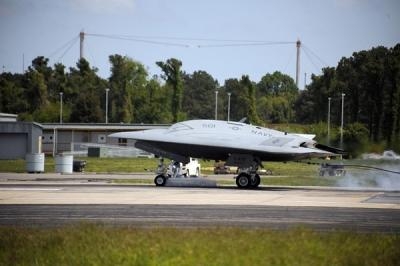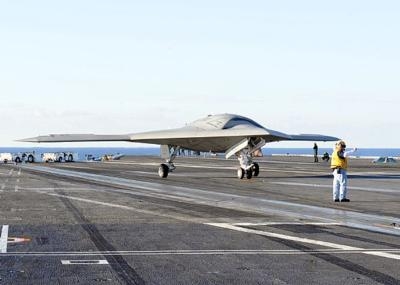Wed, May 08, 2013
Shore-Based Tests Adds Momentum, Confidence For Upcoming Carrier Trials
The first fly-in arrested landing of the X-47B Unmanned Combat Air System (UCAS) demonstrator has been successfully completed by the U.S. Navy and prime contractor Northrop Grumman. Conducted May 4 at the Navy's shore-based catapult and arresting gear complex at Patuxent River Naval Station in Maryland, the test represents the first arrested landing by a Navy unmanned aircraft. It marks the beginning of the final phase of testing prior to carrier-based trials planned for later this month.

"This precision, shore-based trap by the X-47B puts the UCAS Carrier Demonstration (UCAS-D) program on final approach for a rendezvous with naval aviation history," said Capt. Jaime Engdahl, the Navy's UCAS program manager. "It moves us a critical step closer to proving that unmanned systems can be integrated seamlessly into Navy carrier operations."
During an arrested landing, the incoming aircraft extends its landing hook to catch a heavy cable extended across the aircraft landing area. The tension in the wire brings the aircraft to a rapid and controlled stop. Carl Johnson, vice president and Navy UCAS program manager for Northrop Grumman, said this first arrested landing reinforced what the team already knew. "The X-47B air vehicle performs exactly as predicted by the modeling, simulation and surrogate testing we did early in the UCAS-D program," Johnson said. "It takes off, flies and lands within a few feet of its predicted path."
The arrested landing test culminates more than three months of shore-based carrier suitability testing at Naval Air Station Patuxent River. The testing included precision approaches, touch-and-go landings, and precision landings by the X-47B air vehicle. For the arrested landing, the X-47B used a navigation approach that closely mimics the technique it will use to land on an aircraft carrier underway at sea.

Later this month, the aircraft will undergo sea-based carrier testing, catapulting from the carrier deck and potentially completing landings aboard USS George H.W. Bush (CVN 77). "The entire system has performed very well across a large set of shore-based testing events including aircraft performance, flying qualities, navigation performance, catapult launches, and precision landings designed to stress system operation," Engdahl said. "Our final carrier-landing software simulation shows excellent performance, flight test results are very good, and we are confident the X-47B will perform well on the ship."
The X-47B is a tailless, autonomous aircraft designed with unique features for an unmanned aircraft, such as carrier suitable landing gear and structure. While the X-47B itself will not be used for operational use, the UCAS-D program is developing a concept of operations and demonstrating technologies for use in follow-on unmanned carrier based aircraft programs.
(Images provided by the U.S. Navy)
More News
Aero Linx: International Federation of Airworthiness (IFA) We aim to be the most internationally respected independent authority on the subject of Airworthiness. IFA uniquely combi>[...]
Ultrahigh Frequency (UHF) The frequency band between 300 and 3,000 MHz. The bank of radio frequencies used for military air/ground voice communications. In some instances this may >[...]
A Few Questions AND Answers To Help You Get MORE Out of ANN! 1) I forgot my password. How do I find it? 1) Easy... click here and give us your e-mail address--we'll send it to you >[...]
From 2019 (YouTube Edition): Learning To Paint Without Getting Any On Your Hands PPG's Aerospace Coatings Academy is a tool designed to teach everything one needs to know about all>[...]
Also: Sustainable Aircraft Test Put Aside, More Falcon 9 Ops, Wyoming ANG Rescue, Oreo Cookie Into Orbit Joby Aviation has reason to celebrate, recently completing its first full t>[...]
 ANN's Daily Aero-Linx (05.06.25)
ANN's Daily Aero-Linx (05.06.25) ANN's Daily Aero-Term (05.06.25): Ultrahigh Frequency (UHF)
ANN's Daily Aero-Term (05.06.25): Ultrahigh Frequency (UHF) ANN FAQ: Q&A 101
ANN FAQ: Q&A 101 Classic Aero-TV: Virtual Reality Painting--PPG Leverages Technology for Training
Classic Aero-TV: Virtual Reality Painting--PPG Leverages Technology for Training Airborne 05.02.25: Joby Crewed Milestone, Diamond Club, Canadian Pilot Insurance
Airborne 05.02.25: Joby Crewed Milestone, Diamond Club, Canadian Pilot Insurance




